Looking to add a splash of color to your jewelry collection? Turquoise might be the gem you’re seeking. With its captivating hues ranging from serene sky blue to deep teal, this gemstone brings a touch of nature’s artistry to your style.
|
|
|
This Sky-blue gem is an opaque mineral that has captivated civilizations for millennia with its mesmerizing blue-to-green hues. Ancient Egyptians adorned themselves with turquoise jewelry, while Native American cultures revered it as a sacred stone. The gemstone’s allure transcends time, making it a cherished adornment across various societies.
Chemical Composition: Nature’s Blueprint for Beauty
Turquoise is a hydrous phosphate mineral with the chemical formula CuAl₆(PO₄)₄(OH)₈·4H₂O. This composition showcases its unique blend of elements: copper, aluminum, phosphorus, oxygen, and water. Copper plays a key role in producing turquoise’s iconic blue hues, while traces of iron can introduce greenish tones, creating a spectrum of colors.
925 Sterling Silver Natural Gemstone paiderweb Turquoise Pendant Necklace |
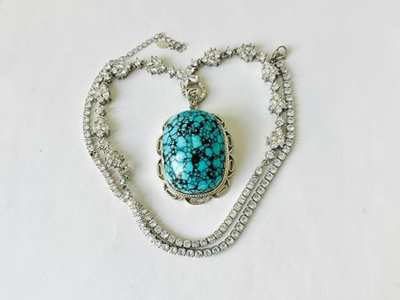
|
| Click on the Image |
Physical Characteristics: Distinctive Yet Delicate
This copper-rich gem is typically opaque, with a waxy to subvitreous luster that adds a soft, glowing appearance. It ranks 5 to 6 on the Mohs scale of hardness, making it less durable than many other gemstones but ideal for jewelry that isn’t subject to heavy wear. Its density ranges between 2.6 and 2.9 g/cm³, reflecting its relatively lightweight nature.
A hallmark of this cryptocrystalline mineral is its matrix, a network of contrasting veins or patches originating from the host rock. This adds a textured, natural look to many stones, enhancing their appeal. The color can vary from vivid sky blue to deep green, depending on the presence of copper or iron and the environmental conditions during its formation.
Formation: A Result of Unique Geological Processes
This gem of the desert forms in arid climates through a secondary mineralization process. Groundwater, enriched with dissolved copper and aluminum, reacts with phosphate minerals in the surrounding rock. Over time, this process creates turquoise in cracks, cavities, and nodules within the host rock, resulting in its distinctive patterns and colors.
Table Of Contents:
- 1) Gemstone Turquoise In A Nutshell
- 2) The Timeless Allure of Natural Turquoise.
- 3) Occurrence in Nature.
- 4) The Vibrant Spectrum of Turquoise Color.
- 5) What Gives Turquoise Its Unique Hue?
- 6) Cultural Significance of Gemstone Turquoise.
- 7) Incorporating The Gem Into Your Style.
- 8) Caring for Your Turquoise Treasures.
- 9) Conclusion.
|
|
Gemstone Turquoise In A NutshellBack To Top |
| Turquoise is formed in select dry and barren spots across the globe. This happens when acidic groundwater, rich in copper, moves down, interacting with minerals loaded with phosphorus and aluminum. This interaction creates a porous, semi-transparent to opaque mix of hydrated copper and aluminum phosphate. | |
| Mineral | Hydrated Phosphate Of Copper And Aluminium |
|---|---|
| Chemical Composition | CuAl6(PO4)4 ·(OH)8·5H2O |
| Color | Blue to green |
| Refractive Index | 1.610 to 1.650 |
| Birefringence | Not detectable |
| Specific Gravity | 2.76 (+0.14, -0.36) |
| Mohs Hardness | 5 to 6 |
| Birthstones & Anniversaries | Turquoise represents December’s traditional birthstone and marks the 11th anniversary gem. |
| Treatments |
|
|
|
The Timeless Allure of Natural TurquoiseBack To Top |
The enduring charm of this celestial stone transcends time and culture. Its opaque blue and green hues have been cherished for millennia. Fine shades of turquoise make each piece unique. Unsurprisingly, it is often called a gem of the ages, continuing to fascinate and inspire.
A Gemstone with Rich History
Civilizations around the world prized this gem. The ancient Egyptians adorned themselves with beads and carved intricate amulets, believing the gem brought protection and good fortune. In Persia, now modern-day Iran, fine turquoise symbolized wealth and status, often set into daggers and horse bridles. The Aztecs crafted stunning turquoise mosaics, embedding the stone into masks and ceremonial objects with deep spiritual significance. This rich history highlights the beauty of this sky-kissed gem and its profound impact on human culture.
Sleeping Beauty Turquoise White Diamond Solid 18K Yellow Gold Ring for Women |

|
| Click on the Image |
In European folklore, the gift of a turquoise ring says, “Forget me not.” It is the national gem of Tibet, where it is considered to grant good fortune, good health & protection from evil. This December’s birthstone is also believed to impart peace to those who wear it.
The gem, when gifted by a loving friend is believed to shield the wearer from negative energy and bring good fortune. It is a symbol of friendship and brings peace to your home.
Historical Importance
Archeologists have found this celestial stone among prehistoric artifacts. Certain families pass Turquoise heirlooms down through many generations. The name of this desert gem traces back to ancient times, and antiquated ornaments still captivate collectors. Many uses of turquoise in jewelry reflect its timeless character.
The gem is among the earliest protection amulets used by men. It was considered to be a sacred stone by the ancients protective against all manners of evil and ill health. It was also known as a symbol of affluence in many ancient cultures.
The Egyptian Pharaohs treasured this jewel. The Aztec kings adulated this celestial stone. The Native American Navajo people hold this gem of the desert very sacred.
|
|
Occurrence in NatureBack To Top |
The gem rough forms deep within the Earth’s crust, and its creation is nothing short of a geological marvel. Let’s delve into how this beautiful gem comes to be.
Formation Through Hydrothermal Processes
Arid regions of our planet play excellent hosts in the formation of this mineral. Such barren & dry regions facilitate downward seepage of copper-rich acidic water. Upon reaching the depths, the chemical-rich water reacts with minerals containing aluminum & phosphorus. The chemical reaction produces hydrated copper-aluminum phosphate. This opaque to semi-translucent porous compound has been named turquoise.
Over time, this creates a mosaic of turquoise deposits, each with its distinctive color ranging from sky blue to greenish hues.
Formation Through Weathering
Another way it forms is through the weathering of copper-bearing minerals. As these minerals break down, copper ions react with other environmental elements to create natural gem rough. This process adds to the gem’s unique patterns and shades, making each piece a one-of-a-kind treasure.
Global Occurrence
We have discovered substantial raw mineral specimens in Iran (formerly Persia). The American Southwest, the Sinai Peninsula in Egypt, and northwest China have also yielded appreciable quantities. History records show the first large-scale mines existed on the Sinai Peninsula around 3,200 BC. The Maghara Wadi mines which are the oldest known-about source of this well-loved mineral were also situated in this region. They supplied this blue-green gemstone to the pharaohs for around two thousand years.
The Legendary Persian Turquoise Mines
Mines were already being excavated in Persia [now Iran] in 2,100 BC. They gave us the revered “Persian turquoise”, celebrated for its bright, robin’s egg blue color. Persian produce was the finest natural gem rough in the world.
Nishapur’s Enduring Legacy
Mines near Nishapur in Iran are the stuff of legends. They have been spawning this gem for centuries. And they continue to do so even today. However, a number of these ancient mines have now been depleted.
Platinum Oval Shape Turquoise and Diamond Halo-Style Necklace Jewelry for Women |

|
| Click on the Image |
China’s Dominance in Modern Production
Nowadays, China accounts for almost seventy-five percent of the global produce. Having said that, stones from China are routinely enhanced for color. As such, they are not regarded to be of good quality.
Gems from the American Southwest
The American Southwest once harbored a booming community of miners. But most of the mines in this region are now closed. Regardless, some copper mines here yield gem-quality rough as a prized by-product.
Diverse Characteristics Across Regions
The prized Persian turquoise is celebrated for its sky-blue color with minimal veining, while American gems from Nevada and Arizona showcase a variety of shades and unique spiderweb patterns. It’s fascinating how the gemstone’s occurrence in nature is as diverse as the landscapes it comes from.
A Diverse Gemstone
The color of turquoise varies depending on its mineral content. Copper gives its characteristic blue color, while the presence of iron can lend it greener tones. The available variety means you have wide options when choosing the gem in jewelry, each piece reflecting a unique blend of the Earth’s natural elements.
|
|
The Vibrant Spectrum of Turquoise ColorBack To Top |
Colorful Appeal
The opaque blue stone stirs your imagination. Its many shades, from soft pastels to intense sky blues, always catch the eye.
Variations In Turquoise Colors
High-quality gems show a pure and vivid blue color. Yet, iron content (if any) in the copper-rich gem can make it present greenish hues that shift its personality. The gem roughs emerge from many regions, where mines from each region imprint their visual stamp.
Natural Beauties and Processed stones
Much of the turquoise that people see today arrives as rough material later cut into cabochons. The untreated cryptocrystalline mineral often maintains a natural beauty. Skilled artisans also reconstitute the gem by blending smaller pieces into a single stone.
Teardrop Turquoise & Black Onyx Gemstone Diamond Dangle Earrings in Solid 14K Yellow Gold Art Deco Jewelry |
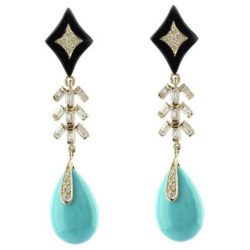
|
| Click on the Image |
Chemical Composition Determines Color
This stone’s composition, including copper and iron, often decides how light or dark it appears. Some turquoise may contain distinct patterns known as spiderweb turquoise. Bisbee turquoise, a well-known variety, shows a unique mix of color and pattern.
Steady Demand And Regional Differences
Turquoise is made through natural processes that occur over long periods, yet it’s demand remains steady. Produced quantities differ from region to region, and the verdant-hued jewels are always changing hands in the trade.
|
|
What Gives Turquoise Its Unique HueBack To Top |
Nature cooks Turquoise when specific minerals interact underground. The amount of gem rough formed, as well as the presence of certain elements, can affect its brightness.
This teal-colored stone gem is a product of the unique chemical reactions between copper, aluminum, and phosphorus in the presence of water over time. The vibrant blue-green hue comes from copper, while the presence of iron can create greenish tones. Traces of zinc, calcium, or other elements also influence its color and texture, making each turquoise stone distinct.
Sky Blue Turquoise And The Gem’s Green Shades
Turquoise is less valuable if it is too green, yet many still prize its earthy charm. Bluer varieties suggest purity and elegance.
The color of this copper-rich gem depends on its mineral composition. Copper creates blue tones and iron introduces green hues. While sky-blue varieties are more valuable due to their rarity and purity, green turquoise carries a rustic appeal cherished for its natural, earthy aesthetic.
Enhancing Colors And Collector Preferences
The gems available today span a spectrum, from delicate pastels to intense, vivid blues. Artisans often craft stunning turquoise mosaic masks, combining pieces of varying shades into breathtaking creations. While dyeing can enhance the color of less vibrant stones, true enthusiasts and collectors often favor untreated gemstones for their authenticity and natural beauty.
|
|
Cultural Significance of Gemstone TurquoiseBack To Top |
This gemstone has been prized in many societies for ages. Different groups have passed down prehistoric artifacts, leaving proof of their enduring value. Turquoise produced by ancient cultures often carried deep meaning. Some believed the blue-green gemstone came as a gift from the earth, while others saw it as a symbol of power.
This relatively soft stone has left an indelible mark on art, spirituality, and trade across cultures. Its value transcended a single tradition, with each society attributing its significance to the gem. Stones lacking vivid color were often treated to enhance their beauty, reflecting an enduring desire to preserve their appeal. Sourced from mineral-rich regions, turquoise often traveled great distances, embedding itself into the spiritual and cultural fabric of diverse civilizations. Wherever it appeared, the sky-blue gem was revered for its beauty, and its profound connection to the divine and the earth.
Platinum Diamond and Cabochon Turquoise Fashion Ring Jewelry For Women |
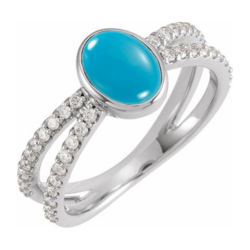
|
| Click on the Image |
Turquoise in Aztec Civilization
This celestial stone played a big role in Aztec life. The Aztecs prized it in sacred rituals and wore it to invoke protection. Prehistoric artifacts reveal Aztec reverence for this gem.
Art And Social Status
Artisans worked turquoise, a soft material, into intricate pieces. They formed masks, jewelry, and symbols that showed status. Much of the produce by Aztec hands became part of royal adornments. Leaders among the Aztecs believed turquoise blue charms strengthened their authority. Certain patterns marked power and respect within the gemstone artistry,
Symbolism Across Different Cultures
Beliefs And Traditions
Different civilizations developed varied meanings for this gem. Some cultures saw it as a guardian against harm. Others believed turquoise without flaws brought harmony. Prehistoric artifacts confirm these beliefs ran deep. Over time, the use of this aquatic-hued stone became linked to unity and healing.
Shifts In Meaning
As trade spread, the name for this gem changed and circulated. Turquoise gems passed from one group to another, blending traditions. Though sourced from select regions, its symbolism traveled far. Even pieces that showed slight changes in tone hinted at shifting values. Artisans often enhanced pale gems. Every culture treasured turquoise blue, embedding its vibrant hue into their traditions and legends.
| Natural Gemstone Turquoise Handmade Amulet Charm Necklaces |
|---|
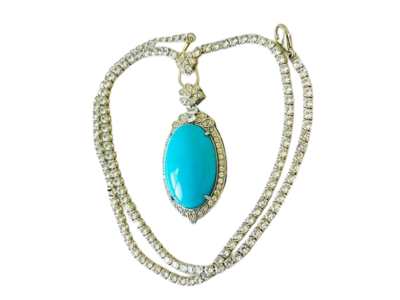
|
| Click on the Image |
Types of Turquoise in Jewelry
This iconic blue gemstone comes in various forms, each offering a unique appeal. Jewelers often shape this soft gemstone into cabochons, highlighting its smooth surface and natural beauty. In today’s markets, the sky-blue gem appears primarily as untreated or stabilized stones to enhance color and durability. Certain varieties, especially those with vivid, rich hues, have captivated collectors and artisans for centuries. Rough material is frequently cut and polished into gemstones displaying these striking blue tones. Smaller fragments are sometimes reconstituted to create a consistent and polished appearance.
Natural vs. Treated Stones
Natural turquoise retains its untouched qualities, showcasing its authentic charm. This opaque blue gemstone, often tinged with hints of green, captivates with its earthy elegance. High-quality stones frequently appear in cabochon designs, meticulously shaped from rough turquoise to highlight their beauty. While pure turquoise is rare, collectors value pieces with minimal treatment, appreciating their unaltered character.
Many prefer stones with natural matrix patterns, as these unique markings tell the story of the gem’s formation. Although the name for this gem may differ across regions, the allure and value of natural turquoise remain universally revered.
Enhancements And Stabilization
Turquoise from natural deposits often lacks the hardness needed for durability. To address this, artisans treat the stone, enhancing its strength and reducing its fragility. Stabilized gems resist damage more effectively and retain consistent color over time. Since this cryptocrystalline mineral naturally contains tiny pores, treatments fill these spaces, improving its resilience and appearance.
Platinum Turquoise and Diamond Halo-Style Fashion Ring Jewelry For Women |
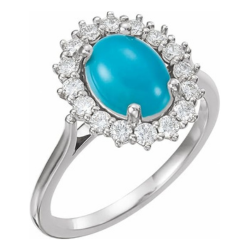
|
| Click on the Image |
Much of the jewels used in commercial jewelry undergoes these processes, making it more suitable for everyday wear. While some purists favor untreated turquoise for its authenticity, stabilized varieties remain highly popular, offering an accessible way for more people to enjoy the beauty of this unique gem.
Understanding Turquoise Treatments
Color And Surface Adjustments
Dyed gems receive artificial color to appear deeper or brighter. A reconstituted stone blends scraps and powders under pressure to make turquoise with consistent shade. These techniques respond to demand, increasing gem numbers suitable for modern styles. Turquoise is rarely uniform, so enhancing it can yield a more balanced look. While some criticize these methods, they do create a variety of options.
Improving Market Availability
Jewelers rely on treatments to meet growing demand. Using these methods, suppliers ensure a steady production. Rough material comes primarily from certain mines, but not every deposit yields flawless material. Stabilization and dyeing ensure that this gem of the desert is available to more people. Although some consider treated stones less authentic, the practices keep this gemstone within easy reach.
The Rise of Synthetic Turquoise
Mimicking Natural Beauty
Synthetic simulants often blend pigments and binders. They produce convincing colors that resemble high-quality gems. While such stones lack the history of the oldest turquoise sources, they present a lower-cost option. People who admire turquoise blue can now access these affordable substitutes. The use of such alternatives keeps prices manageable.
Influence On The Market
The presence of synthetic options shapes what consumers see. Egyptian turquoise and Aztec turquoise varieties influenced cultures long ago, but today’s consumers face many choices. Some buyers accept these simulants, enjoying their color without worrying about authenticity. Others want only natural or lightly treated stones. Regardless, synthetic offerings ensure this gemstone remains a favorite, echoing its long past through new, modern forms.
|
|
Incorporating The Gem Into Your StyleBack To Top |
Turquoise adds a bold and refreshing touch to any wardrobe, blending seamlessly with casual and formal looks. This vibrant gemstone has adorned humans for centuries, showcasing its timeless versatility. Jewelers craft smooth cabochons from raw materials, highlighting their natural beauty and unique textures. Modern turquoise jewelry ranges from untreated stones to dyed pieces, offering options to suit various preferences. Renowned for its dynamic character, turquoise inspires creative pairings, encouraging wearers to experiment with fresh and striking combinations.
Choosing the Right Turquoise Pieces
Evaluating Authentic Qualities
Natural gems often reveal subtle imperfections that add character and depth. Many collectors gravitate toward stones without artificial treatments, valuing the unique markings that tell the story of their formation. These gemstones rarely display a perfectly uniform appearance, which enhances their distinct charm. High-quality stones with their natural hue intact appeal to those who appreciate the beauty of unaltered craftsmanship.
Natural Turquoise Statement Ring Yellow Gold Band Rings |
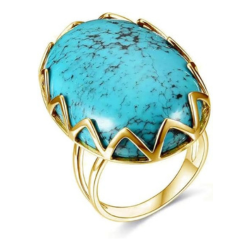
|
| Click on the Image |
Factors Influencing Your Decision
Some people prefer reconstituted or dyed turquoise for its vibrant, consistent color, making it an excellent choice for bold fashion statements. The gem is widely available, with each piece offering unique qualities to suit different tastes. While untreated stones showcase natural patterns, treated varieties provide versatility for pairing with specific outfits. Whether selecting minimalist earrings or striking necklaces, prioritize authenticity and personal style to create a look that reflects individuality.
Creative Ways to Wear Turquoise Jewelry
Blending With Different Styles
Pairing cabochons with contrasting colors adds a captivating element to your look. This gemstone showcases a range of tones, from soft, muted pastels to striking turquoise blue. When paired with darker fabrics, its vibrant color truly stands out. For a bohemian aesthetic, layering multiple turquoise pieces creates a relaxed yet stylish vibe. Alternatively, a single, well-crafted accessory offers understated elegance that suits any occasion.
Adapting To Changing Trends
This iconic blue-green gemstone continues to evolve as jewelry design embraces innovative techniques. Even reconstituted turquoise introduces modern appeal without losing its timeless essence. Mixing this aquatic-hued stone gemstone with complementary stones or pairing it with sleek, contemporary metals opens up endless creative possibilities. High-quality turquoise elevates any outfit, seamlessly blending traditional charm with cutting-edge fashion trends.
|
|
Caring for Your Turquoise TreasuresBack To Top |
Simple Tips to Keep Them Radiant
This relatively soft gemstone requires special care to preserve its vibrant color and natural beauty. Avoid exposing your turquoise jewelry to harsh chemicals, including perfumes, cleaning agents, or cosmetics, as they can damage its surface. Since this is a porous gemstone, moisture can seep into it and affect its appearance and color over time. Always clean your jewelry pieces gently using a soft, damp cloth to remove dirt and maintain their radiance.
Platinum Natural Peridot and Natural Turquoise Halo-Style Ring |
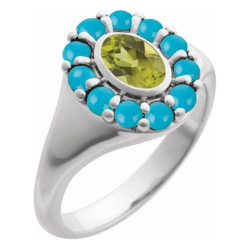
|
| Click on the Image |
When storing your jewelry, keep it separate from harder gemstones or metals to avoid scratches. Placing them in a fabric-lined jewelry box or wrapping them in a soft cloth can help minimize friction. Store them in a dry place away from extreme temperatures, and never use ultrasonic cleaners or steam to clean them. These simple habits maintain the gemstone’s shine and protect its delicate surface from unnecessary wear.
Protecting Your Jewelry for Lasting Beauty
To ensure your turquoise treasures remain beautiful, take precautions during daily activities. Remove your jewelry when you engage in strenuous tasks or handling water to prevent accidental damage. Prolonged exposure to sunlight can also fade the gem’s vivid hues, so avoid leaving your pieces in direct sunlight for extended periods.
Choosing jewelry with secure settings can provide additional protection for turquoise stones. Bezel settings, for instance, offer more coverage and stability than prongs, making them ideal for safeguarding the stone in rings or pendants. Please inspect your jewelry meticulously for loose settings or signs of wear, and have them repaired promptly by a professional jeweler. With mindful care, your collection can maintain its timeless allure for years.
|
|
ConclusionBack To Top |
This December birthstone stands as a gemstone of rich history and enduring allure, cherished across cultures for its beauty and symbolism. From ancient civilizations to modern jewelry enthusiasts, turquoise continues to captivate with its striking hues and storied origins. Its formation in arid regions, combined with the unique influence of copper, gives each piece its distinct charm.
| See Also: | Mens Turquoise Bracelets |
See More Gemstones As Follows